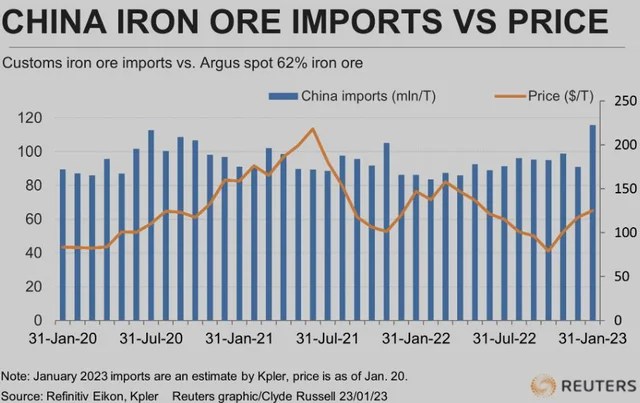In the steel index of the New York Stock Exchange, the price of a ton of steel on Friday (January 20) traded at $ 1964.12, up from $ 1458.37 in early October – when the price down from record highs in March and April 2022.
Similarly, in China, the price of rebar also increased above 4,100 CNY/ton, the highest level within 5 months in the context of increasing demand.
The increase in steel prices has many reasons.
In China, GDP in the fourth quarter and industrial production in December both increased more than market expectations, signaling the possibility of recovery when the country ends strict lockdown measures against COVID-19.
The end of the Zero COVID policy and major initiatives to boost construction activity, such as the central bank’s liquidity injection and new credit lines for property developers are expected to help strengthen the credit health of the real estate sector and stimulate housing demand.
On the supply side, the global crude steel production scene slowed, especially in China, the top producer with 52% of the world’s output. Commodity surveyors noted a sharp drop in iron ore exports from major producer Brazil, leaving blast furnaces without enough raw material to make steel. In addition, tornadoes and maintenance programs in the first quarter risk reducing exports from the world’s top producer, Australia.
Supply is unlikely to be replenished, with shipments from top exporters Australia likely to grow only marginally, while shipments from second-largest exporter Brazil are expected to remain steady throughout the year 2023.
Spot iron ore prices have been one of the main beneficiaries of strong demand expectations as China reopens its economy after abandoning its strict anti-COVID restrictions.
While other commodities, such as crude oil and copper, have also recently gained on the back of China’s recovery story, the iron ore recovery seems to be based on increased real demand.
The delivery price of iron ore with 62% Fe content – a reference for the global iron ore market – announced by the commodity price reporting agency Argus, on January 20 reached $126/ton, 7.1% higher than at the beginning of the year, and is up 59.5% since last year’s low of $79/ton reached on October 31. February iron ore futures on the Dalian Exchange (China) on January 13 hit a 17-month high of 896.5 yuan ($132.23) per ton. Although the price has dropped a bit since then, the price of 856.6 CNY on January 20 is still quite high.
To maintain an upbeat view on iron ore prices, evidence of increased steel production and demand in China is needed.
At first glance, the increase in the price of the main raw material in steel production does not seem to correspond with the imports of China, which dominates global sea trade – buying about 70% of all seaborne volumes worldwide.
China’s iron ore imports in December were 90.86 million tons, down from 98.85 million tons in November and also weaker than October’s 94.98 million tons.
However, December has historically been a consistently low month for China’s iron ore imports, and the December 2022 results were actually 5.6% higher than December 2021 imports.
What’s more important for spot iron ore prices is that January imports appear to be surging, according to port and ship tracking data compiled by commodity analysts Kpler and Refinitiv.
Kpler data shows China is on track to import 115.6 million tonnes of iron ore in January, while Refinitiv estimates 116.8 million tonnes.

Iron ore price chart and China’s imports.
Figures from cargo analysts do not exactly match official customs figures due to differences in when goods are assessed as cleared.
In addition, the shipping figures do not take into account the small volumes of iron ore shipped overland from China’s neighbors Russia and Mongolia.
However, January estimates suggest that this is an extremely strong month of iron ore imports into the country, possibly even surpassing the record high of 112.65 million tons in July 2020.
Official import data may have to wait until March, as in recent years Chinese customs have not reported January and February figures separately, instead combining the first two months for filtering changes due to the change in the time of the Lunar New Year holiday.
It is also worth noting that in the context of such high imports, China’s steel output in December also increased by 4.5% compared to November to 77.89 million tons, although the output in 2022 is 1.10 billion tons, down 2.1% from the record high reached in 2021.
The rapid rise in iron ore prices is causing some anxiety in Beijing, with the country’s policymaking body recently warning three times that it will take tough measures against investment excessive muscle.
It is not clear that the prospect of world iron and steel prices will continue to increase or stop, but at least in the first quarter of 2023, iron and steel is forecasted to still be a commodity that attracts great attention of investors around the world gender.
References: Refintiv, Businessdailyafrica
Source: Vietnam Insider
